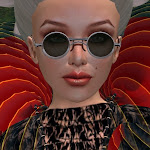Just happened upon this video of a presentation that the Dallas Museum of Art hosted for the University of Texas' as part of their Dallas Virtual Worlds event last spring.
One of the speakers stresses the importance of design around participatory experiences, saying that structures by themselves are not sufficient. I think this is a problem most virtual creators have to learn to cope with... but would suggest that keeping relevant in-world groups informed and blogging are two good ways to ensure that a work gets seen. The video was an eye-opener for me and a window on the process that artists and educators go through as they discover the possibilities in virtual spaces... but I kept wanting to shout out, "But wait! Have you considered X?"
Wednesday, September 17, 2008
Educators are looking into art and design in virtual worlds
Posted by
Bettina Tizzy
at
1:53 PM
![]()
Labels: art, Dallas Museum of Art, Dallas Virtual Worlds, education, gallery, metaverse, research, University of Texas, visual








4 comments:
YES! I AM an educator and WORK with educators. I suggest interactivity constantly! I think some educators are a bit put off by the scripting. However, even a marginal scripter can do a TON. Even making sure to leave clues for the learner by "tagging" objects with information (Make sure tips is on!) can be huge. And Hilary Mason' AutoScript Generator makes it easy to make "stuff do stuff". ( http://www.3greeneggs.com/autoscript/ )
Thanks for the great post! (I love this site)
Cathy/Mari Asturias
Ha! Welcome to this blog, Cathy and thank you for the suggestions. I wonder how artists might work with educators to enhance the learning experience, and widen the acceptance of virtual worlds as a platform for education.
As I viewed this video, I kept wishing the panelists had seen some of the art that is in place in Second Life and considered ways of integrating it into the learning experience.
Schools and universities need a "door opener" for a later communication of scientific content related to their institution. This must be interactive, npirl and fun, but with an educational backbone. For example I can name a project from the University of South Florida:
USF's exhibit is a showcase of Florida's fascinating history, natural habitats and wildlife. Central to the exhibit is an old-fashioned tube ride which carries visitors on a peaceful creek tour through the many featured displays. Highlights include an authentic Seminole "chickee," a cracker house, and a recreation of the bell tower from Castillo de San Marcos. Also featured are various habitats such as a springs with a detailed cave system, cypress swamp, salt marsh, and pine forest. Informational signs along the way dispense note cards containing short, interesting descriptions and photos.
In cooperation with USF and FSU we have called this "Edu-Cultural Projects". Here the visitor enjoys a fully immersive experience that introduces them not only to the school's geography, but also to its history and culture in a way that is interesting, educational and fun. Schools bring more than bricks and mortar to SL. They bring their individual cultural identity in a safe environment, making the "first step" for visitors much more easy.
The USF SIM will be opened soon, if you want a preview you can contact me.
Hi kitsune! I agree that it helps if the new user's first experiences feel safe and relatively familiar, especially since they already have so many things to figure out. All the more so if they are able to actually learn something about the place that is being represented.
What you describe sounds like an accurate and pleasant PIRL (possible in real life) recreation of Real Life habitats and places, which definitely has its place in virtual worlds.
I suppose that NPIRL needs to be a step or a few down that user's road, when they have the basics down pat and are ready to push the boundaries of what they know or even imagine.
A good bridge point between PIRL and NPIRL that is still educational might be a place like David Rumsey's Maps, a four-sim experience that would be impossible to create and visit in Real Life, and yet does an extraordinary job of communicating the topography of Yosemite Valley in the 1800s: http://npirl.blogspot.com/2008/02/david-rumseys-maps-nathan-babcocks.html.
Post a Comment